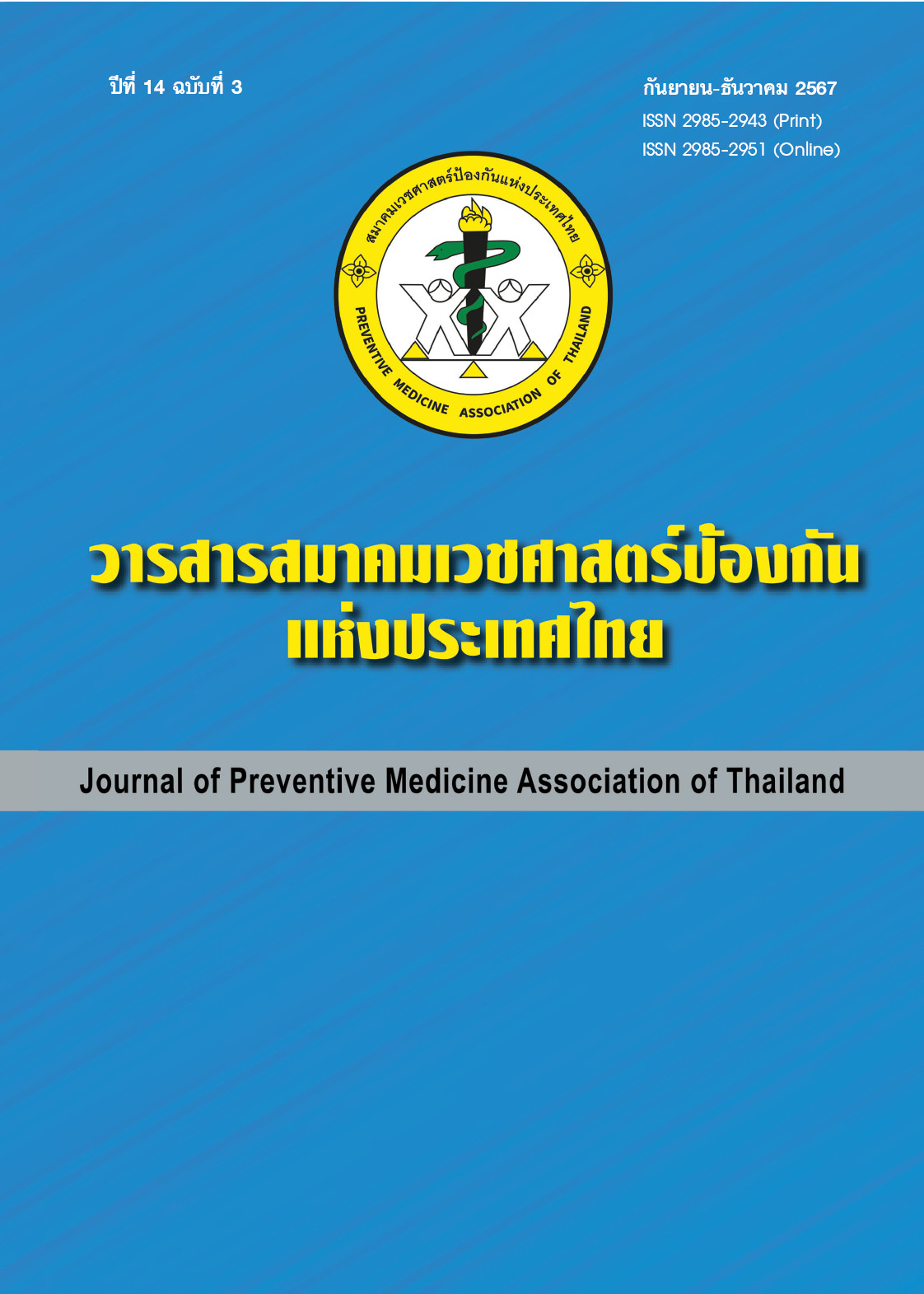The Relationship of Obesity Indices with Metabolic Syndrome in Patients with Type 2 Diabetes Mellitus
Keywords:
metabolic syndrome, Type 2 diabetes, obesity indexAbstract
Objective: To compare the prevalence and identify the optimal cutoff values of obesity indices related to metabolic syndrome in patients with Type 2 Diabetes Mellitus (T2DM) between males and females. Methods: This cross-sectional analytical research collected data from T2DM patients diagnosed at Sam Phran Hospital. The study examined obesity indices in T2DM patients receiving annual check-ups between December 2023 and March 2024. A sample size of 448 was calculated, consisting of 224 males and 224 females. Data were collected using general questionnaires and laboratory results to determine obesity indices. Data analysis employed descriptive statistics and inferential statistics including independent t-test, Chi-square test or Fisher exact test and optimal cutoff values were determined using diagnostic tests to present sensitivity, specificity and the area under the ROC curve. Results: Among 224 male T2DM patients, 112 (50.00%) had metabolic syndrome (Mets), and among 224 female T2DM patients, 106 (47.32%) had metabolic syndrome (Mets). The obesity indices associated with metabolic syndrome in both genders are Lipid Accumulation Product (LAP): Males: Cut-off value of 38.22, sensitivity of 85%, specificity of 66%, ROC curve of 0.75 Females: Cut-off value of 52.74, sensitivity of 75%, specificity of 75%, ROC curve of 0.75, Triglyceride - Glucose Index (TyG index): Males: Cut-off value of 9.125, sensitivity of 79%, specificity of 84%, ROC curve of 0.81 Females: Cut-off value of 9.155, sensitivity of 81%, specificity of 81%, ROC curve of 0.81, Visceral Adiposity Index (VAI): Males: Cut-off value of 3.82, sensitivity of 83%, specificity of 81%, ROC curve of 0.82 Females: Cut-off value of 5.54, sensitivity of 79%, specificity of 86%, ROC curve of 0.83 Conclusion: The prevalence of metabolic syndrome in male T2DM patients is 50% and 47.32% in female T2DM patients. The obesity indices related to metabolic syndrome include the LAP, TyG index, and VAI.
References
สมาคมโรคเบาหวานแห่งประเทศไทย ในพระราชูปถัมภ์สมเด็จพระเทพรัตนราชสุดาฯ สยามบรมราชกุมารีและสมาคมต่อมไร้ท่อแห่งประเทศไทย. แนวทางเวชปฏิบัติสำหรับโรคเบาหวาน 2566. กรุงเทพฯ: สมาคมโรคเบาหวานแห่งประเทศไทย ในพระราชูปถัมภ์สมเด็จพระเทพรัตนราชสุดาฯ สยามบรมราชกุมารีและสมาคมต่อมไร้ท่อแห่งประเทศไทย; 2566.
วิชัย เอกพลากร. Thai National Health Examination Survey and System Development for Innovation and Policy Making Utillzation. กรุงเทพฯ: มหาวิทยาลัยมหิดล; 2565.
วิชัย เอกพลากร, หทัยชนก พรรคเจริญ, วราภรณ์ เสถียรนพเก้า. การสำรวจสุขภาพประชาชนไทยโดยการตรวจร่างกาย ครั้งที่ 6 พ.ศ. 2562-2563. กรุงเทพฯ: คณะแพทยศาสตร์โรงพยาบาลรามาธิบดี มหาวิทยาลัยมหิดล, 2564.
อภิรดี ศรีวิจิตรกมล. โรคเบาหวานในตำราอายุรศาสตร์ทั่วไป. กรุงเทพฯ: ภาพพิมพ์; 2556.
Isomaa B, Henricsson M, Almgren P, Tuomi T, Taskinen MR, Groop L. The metabolic syndrome influences the risk of chronic complications in patients with Type II diabetes. Diabetologia 2001;44(9):1148-54.
Tan CE, Ma S, Wai D, Chew SK, Tai ES. Can we apply the National Cholesterol Education Program Adult Treatment Panel definition of the metabolic syndrome to Asians? Diabetes Care 2004;27(5):1182-6.
Jao HF, Wung CH, Yu HC, Lee MY, Chen PC, Chen SC, et al. Sex Difference in the associations among obesity-related indices with metabolic syndrome in patients with type 2 diabetes mellitus. Int J Med Sci 2021;18(15):3470-77.
Motamed N, Sohrabi M, Poustchi H, Maadi M, Malek M, Keyvani H, et al. The six obesity indices, which one is more compatible with metabolic syndrome? A population based study. Diabetes Metab Syndr 2017;11(3):173–7.
Barnett AH, Dixon AN, Bellary S, Hanif MW, O’Hare JP, Raymond NT, Kumar S. Type 2 diabetes and cardiovascular risk in the UK south Asian community. Diabetologia 2006;49:2234-46.
Taniguchi A, Fukushima M, Nakai Y, Kuroe A, Ohya M, Ohgushi M, et al. Factors responsible for the evolution of insulin resistance in Japanese type 2 diabetic patients: association with atherosclerosis. Diabetes Res Clin Pract 2007;77(3):213-9.
Jao H, Wung C, Yu H, Lee M, Chen P, Chen S, et al. Sex difference in the associations among obesity-related indices with metabolic syndrome in patients with type 2 diabetes mellitus. Int J Med Sci 2021;18(15):3470-77.
Kaur H, Sidhu S, Sambyal V. Association of Obesity Indices with type 2 diabetes mellitus and coronary artery disease. J Hum Ecol. 2010;29(3):185-90.
Jayawardana R, Ranasinghe P, Sheriff MHR, Matthews DR, Katulanda P. Waist to height ratio: a better anthropometric marker of diabetes and cardio-metabolic risks in South Asian adults. Diabetes Res Clin Pract 2013;99(3):292-9.
Witarto BS, Witarto AP, Visuddho V, Wungu CDK, Maimunah U, Rejeki PS, et al. Gender-specific accuracy of lipid accumulation product index for the screening of metabolic syndrome in general adults: a meta-analysis and comparative analysis with other adiposity indicators. Lipids Health Dis 2024;23(1):198.
Singh B, Saxena A. Surrogate markers of insulin resistance: a review. World J Diabetes 2010;1(2):36–47.
Wan H, Cao H, Ning P. Superiority of the triglyceride glucose index over the homeostasis model in predicting metabolic syndrome based on NHANES data analysis. Sci Rep 2024;14(1):15499.
Bijari M, Jangjoo S, Emami N, Raji S, Mottaghi M, Moallem R, et al. The accuracy of Visceral Adiposity Index for the screening of metabolic syndrome: a systematic review and meta-analysis. Int J Endocrinol 2021;2021:6684627.
Downloads
Published
How to Cite
Issue
Section
License
Copyright (c) 2024 สมาคมเวชศาสตร์ป้องกันแห่งประเทศไทย

This work is licensed under a Creative Commons Attribution-NonCommercial-NoDerivatives 4.0 International License.
บทความที่ลงพิมพ์ในวารสารเวชศาสตร์ป้องกันแห่งประเทศไทย ถือเป็นผลงานวิชาการ งานวิจัย วิเคราะห์ วิจารณ์ เป็นความเห็นส่วนตัวของผู้นิพนธ์ กองบรรณาธิการไม่จำเป็นต้องเห็นด้วยเสมอไปและผู้นิพนธ์จะต้องรับผิดชอบต่อบทความของตนเอง






